ANTIOXIDANTS
Our body is in a constant battle against infection, diseases, and the formation of free radicals. However, there’s a secret weapon that can help us fight against these issues: antioxidants!
Antioxidants are elements such as vitamins A, C, and E that counteract the damage caused by free radicals and help protect our healthy cells.
Free radicals are the molecules that contain unpaired electrons, which make them highly reactive. In this form, they can cause damage by attacking healthy cells, and when these cells grow weakened, we become more vulnerable to disease.
Free radicals may be produced from normal body functions such as breathing or physical activity, but they are mainly formed from our exposure to junk and highly processed food and environmental hazards, such as pesticides, air pollution, supermarket cleaning products and cigarette smoke. Antioxidants work to disable the disease-causing free radicals, thus preventing the damage from occurring. Although our body naturally produces antioxidants, it doesn’t produce enough to protect us from free radicals, so that is why it is important to include antioxidant-rich foods in our diet on a regular basis.
Antioxidant – Rich Foods
Fruits, vegetables, whole grains, legumes, and nuts all contain an intricate mix of antioxidants, so eating a variety of these healthy foods will help ensure that we are getting plenty of these disease-fighting nutrients.
Here are some ways we can include antioxidant-rich foods into our diet:
- Consume at least 3 to 5 fruits and/or vegetables every day.
- Choose fruits and vegetables rich in colors like blue, purple, red, orange, yellow, and green, because they often pack the most nutrients and antioxidants.
- Green Smoothies are an awesome way to reap the health benefits of antioxidants. Try blending darkly leave vegetables with carrots, celery, ginger, lime, intelligent fiber, hemp seeds and filtered water.
- Try blending darkly colored frozen or fresh berries such as blueberries, strawberries, blackberries, and banana with chia seeds and hemp seeds for a very refreshing antioxidant rich smoothie.
- Antioxidants are also found in grain products. Oats, in particular, are an excellent source for incorporating antioxidants into our daily diet. Oatmeal and oat bran are two good food choices.
- Let’s eat our legumes: red beans, kidney beans, black beans, and pinto beans are all rich sources of antioxidants.
- Cooking with herbs and spices like dried oregano, turmeric, cinnamon, cloves, and ginger supply excellent doses of antioxidants.
There are thought to be hundreds and possibly thousands of substances that can act as antioxidants. Each has its own role and can interact with others to help the body work effectively.
Examples of antioxidants that come from outside the body include:
- vitamin A
- vitamin C
- vitamin E
- anthocyanins
- beta-carotene
- lycopene
- lutein
- flavonoids
- zeaxanthin
- catechins
- polyphenols
Flavonoids, flavones, catechins, polyphenols, anthocyanins, and phytoestrogens are all types of antioxidants and phytonutrients, and they are all found in plant-based foods.
Therefore, I chose to share information about anthocyanins because they benefit our microbiome, heart, eyes, brain, and our immune system. Furthermore, this plant food is delicious and every single of my recipes is highly enjoyable, easy to prepare and packed with awesome nutrients for our whole body.
ANTHOCYANINS
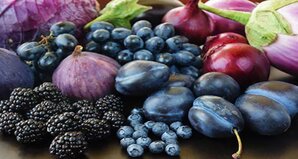
What are Anthocyanins and what benefits do they offer?
Anthocyanins are a type of flavonoid, a family of powerful antioxidants that fight the effects of aging and oxidative stress, but also anthocyanins offer anti-inflammatory, anti-viral, and anti-cancer benefits.
In addition, anthocyanins have been reported as having the capacity to lower blood pressure, improve visual acuity, reduce cancer cell proliferation, inhibit tumor formation, prevent diabetes, lower the risk of CVD (Cardio Vascular Disease) modulate cognitive and motor function. Furthermore, anthocyanins improve cholesterol levels and blood sugar metabolism.
Where are anthocyanins found?
Anthocyanins are found naturally in a number of foods, they are the pigments that give red, purple, and blue plants their rich coloring.
Anthocyanins protect purple vegetables from sunlight damage, cold temperatures, and other stressors. And they attract pollinators, like bees and butterflies.
Due to their diverse physiological activities, the consumption of anthocyanins plays a significant role in preventing lifestyle-related diseases such as cancer, diabetes, and cardiovascular and neurological diseases.
What foods contain Anthocyanins?
Foods Highest in Anthocyanins
- Black raspberries.
- Black currants.
- Blueberries.
- Blackberries.
- Red cabbage.
- Black plums.
- Red radish.
- Red raspberries
- Black beans
- Tart cherries
- Purple onions
- Purple sweet potatoes
4 More Reasons to Eat More Purple Foods
Anthocyanins have a wide range of health-promoting benefits.
Science is showing that they are:
- Anti-Inflammatory — Anthocyanins have consistently shown to reduce inflammation. Why is this important? Because chronic inflammation is one of the underlying causes of many diseases of our times. Including Alzheimer’s disease, asthma, heart disease, allergies, type 2 diabetes, arthritis and joint disease, depression, some types of cancer, and obesity.
- Heart Healthy — Consuming a high number of anthocyanins has been shown by a 2012 study published in The American Journal of Clinical Nutrition to improve many cardiovascular risk factors, including ability to lower artery stiffness and lower blood pressure.
- Anti-Cancer — Anthocyanins are associated with cancer prevention. For example, a 2013 study published in Molecular Nutrition & Food Research suggests that purple sweet potato may protect against colorectal cancer — the third most common cancer. And purple corn, though difficult to find, may have particularly potent cancer-fighting power. In research by Monica Giusti, PhD, purple corn showed significant blockage of colon cancer cells.
- Good for Our Brain — A 2003 study published in the Archives of Pharmacal Research showed the memory-enhancing effects of eating purple sweet potatoes. Other research points to the ability of anthocyanins to help prevent age-related decline in the nervous system. And anthocyanins are able to cross the blood-brain barrier and localize inside brain regions involved in learning and memory.
Are Purple Vegetables Healthier?
Some purple vegetables have more health benefits compared to the same veggies in other colors — at least for some nutrients.
For example:
- Purple potatoes have four times as many antioxidants as Russet potatoes, due to the anthocyanins.
- Compared to orange carrots, purple carrots have two times the amount of alpha and beta-carotene. (The body converts beta-carotene into vitamin A — another important antioxidant that improves immunity and is good for eye health.)
- Red cabbage contains 36 different types of antioxidants. And it’s been shown to have six to eight times more vitamin C than green cabbage.
- Red Delicious apples provide more anthocyanins than Fuji apples.
- Black raspberries are a far richer source than red raspberries and
- Concord grapes are a much more concentrated source than red grapes.
Plums
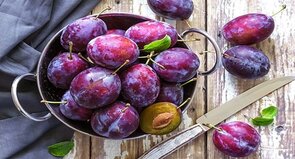
They’re one of the first purple foods people think of. And the more color in the fruit, the more of those anthocyanins. Riper fruits will also have more usable nutrients. The peel could have as much as 20 times the antioxidants as the flesh inside.
Berries

Though anthocyanins are linked to the color purple, the pigments can range from red to blue. Blueberries, blackberries, strawberries, bilberries, black currants, and mulberries all have similar properties. They may boost our brainpower and our mood, according to studies of kids and adults using blueberries. Scientists think the anthocyanins help our brain cells talk to each other.
Potatoes

Try the ones with purple skin and flesh. Besides anthocyanins, they have 2-3 times the total antioxidants of a typical white potato, which is loaded with potassium, magnesium, vitamin C, and fiber.
Red Cherries
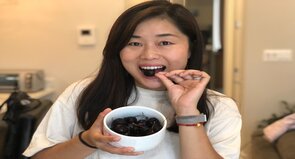
The anthocyanins that give them their dark rich color may help lower our blood pressure and keep our blood vessels healthy and soft. They also seem to help with joint problems like osteoarthritis and gout, a painful condition where crystals gather in our feet or ankles. And cherries are bursting with nutrients that together may help prevent cancer, heart disease, and diabetes.
Grapes
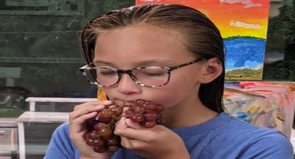
The anthocyanins of grapes can run from red to black. These juicy gems are known for having resveratrol, which has gotten a lot of attention for being part of a group of nutrients that work together to help protect our cells from damage that can lead to disease. The skins of grapes give red wine its color — and its resveratrol
Purple Carrots
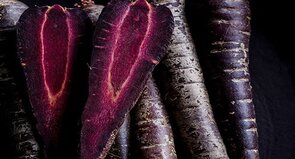
Find them at your local farmers’ market or foodie restaurant. Try them roasted, picked, or broiled. You will get their extra anthocyanins as well as the beta carotene and other carotenoids found in orange carrots that may help stop cancer and improve our immune system.
Red Cabbage
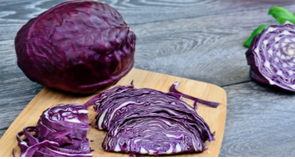
It may be easier for our body to use its anthocyanins when we cook it. And when we ferment cabbage to make sauerkraut or kimchi, we’ll get natural probiotics that nourish the bacteria in our gut — our “microbiome.” These help our body fight germs, absorb nutrients, digest food, and even control anxiety.
Beets
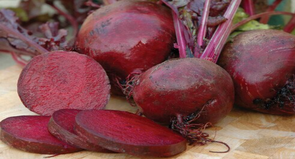
Their color comes from different antioxidants called betaines instead. We’ll also find these red and yellow pigments in the stems of chard and rhubarb, as well as some mushrooms and fungi. They break down more easily when we cook them than anthocyanins do, so try steaming rather than roasting. Beets will add sweetness and a beautiful purplish-red color to our smoothies. These veggies are good for our heart, brain, and blood sugar.
Blueberries

Blueberries have the highest antioxidant capacity of all popular fruits and vegetables. Flavonoids appear to be the berries’ antioxidant with the greatest impact.
Research suggest that anthocyanins in blueberries have beneficial effects on insulin sensibility and glucose metabolism The antioxidants in blueberries seem to benefit our brain by aiding brain function and delaying mental decline.
Some evidence indicates that eating fruits rich in anthocyanins — such as blueberries — is associated with a reduced risk of heart attacks, lowering blood pressure and oxidized LDL cholesterol. Therefore, Regular blueberry intake is tied to lower blood pressure in numerous studies.
Several studies suggest that blueberries and blueberry juice reduce DNA damage, which is a leading driver of aging and cancer.
Phytonutrients: Plant-Based Perks
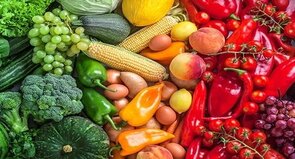
Eat the Rainbow. Of course, you shouldn’t switch to only eating purple foods. But a Rainbow dish is always the best option.
When it comes to healthy eating, you’ve probably heard this advice. That’s because munching on a variety of colorful produce will give you lots of different phytonutrients. There are thousands of these compounds in plants. And they’re not just pretty to look at — they may also fight disease, especially when they work together. Find out about some of the more common ones, where to find them, and how they can benefit your health.
References
Wallace TC. Anthocyanins in cardiovascular disease. Adv Nutr. 2011;2:1-7.
Roy HJ, Lundy S, Eriksen C, Kalicki B. Anthocyanins. Pennington Nutrition Series. havehttp://www.pbrc.edu/training-and-education/pdf/pns/pns_anthocyanins.pdf. 2009.
Tsuda T. Dietary anthocyanin-rich plants: biochemical basis and recent progress in health benefits studies. Mol Nutr Food Res. 2012;56(1):159-170.
Hidalgo M, Martin-Santamaria S, Recio I, et al. Potential anti-inflammatory, anti-adhesive, anti/estrogenic, and angiotensin-converting enzyme inhibitory activities of anthocyanins and their gut metabolites. Genes Nutr. 2012;7(2):295-306.
Wu X, Beecher GR, Holden JM, Haytowitz DB, Gebhardt SE, Prior RL. Concentrations of anthocyanins in common foods in the United States and estimation of normal consumption. J Agric Food Chem. 2006;54(11):4069-4075.
Mink PJ, Scrafford CG, Barraj LM, et al. Flavonoid intake and cardiovascular disease mortality: a prospective study in postmenopausal women. Am J Clin Nutr. 2007;85(3):895-909.
Rimm EB, Giovannucci EL, Willett WC, et al. Prospective study of alcohol consumption and risk of coronary disease in men. Lancet. 1991;338(8765):739-742.
Cassidy A, O’Reilly EJ, Kay C, et al. Habitual intake of flavonoid subclasses and incident hypertension in adults. Am J Clin Nutr. 2011;93(2):338-347.
Cassidy A, Mukamal KJ, Liu L, Franz M, Eliassen AH, Rimm EB. High anthocyanin intake is associated with a reduced risk of myocardial infarction in young and middle-aged women. Circulation. 2013;127(2):188-196.
Jennings A, Welch AA, Fairweather-Tait SJ, et al. Higher anthocyanin intake is associated with lower arterial stiffness and central blood pressure in women. Am J Clin Nutr. 2012;96(4):781-788.
Chiva-Blanch G, Arranz S, Lamuela-Raventos RM, Estruch R. Effects of wine, alcohol and polyphenols on cardiovascular disease risk factors: evidences from human studies. Alcohol Alcohol. 2013;48(3):270-277.
Jin Y, Alimbetov D, George T, Gordon MH, Lovegrove JA. A randomised trial to investigate the effects of acute consumption of a blackcurrant juice drink on markers of vascular reactivity and bioavailability of anthocyanins in human subjects. Eur J Clin Nutr. 2011;65(7):849-856.
Sankhari JM, Thunaojam MC, Jadeja RN, Devkar RV, Ramachandran AV. Anthocyanin-rich red cabbage (Brassica oleracea L.) extract attenuates cardiac and hepatic oxidative stress in rats fed an atherogenic diet. J Sci Food Agric. 2012;92(8):1688-1693.
Graf D, Seifert S, Jaudszus A, Bub A, Watzl B. Anthocyanin-rich juice lowers serum cholesterol, leptin, and resistin and improves plasma fatty acid composition in Fischer rats. PLoS One. 2013;8(6):e66690. doi:10.1371/journal.pone.0066690.
Wang LS, Stoner GD. Anthocyanins and their role in cancer prevention. Cancer Lett. 2008;269(2):281-290.
Wang LS, Hecht SS, Carmelia SG, et al. Anthocyanins in black raspberries prevent esophageal tumors in rats. Cancer Prev Res (Phila). 2009;2(1):84-93.
Lim S, Xu J, Kim J, et al. Role of anthocyanin-enriched purple-fleshed sweet potato p40 in colorectal cancer prevention. Mol Nutr Food Res. 2013;57(11):1908-1917.
Rossi M, Garavello W, Talamini R, et al. Flavonoids and the risk of oral and pharyngeal cancer: a case-control study from Italy. Cancer Epidemiol Biomarkers Prev. 2007;16(8):1621-1625.
Bosetti C, Bravi F, Talamini R, et al. Flavonoids and prostate cancer risk: a study in Italy. Nutr Cancer. 2006;56(2):123-127.
Bode U, Hasan C, Hulsmann B, Fleischhack G. Recancostat compositum therapy does not prevent tumor progression in young cancer patients. Klin Padiatr. 1999; 211(4):353-355.
Wang LS, Sardo C, Rocha CM, et al. Effect of freeze-dried black raspberries on human colorectal cancer lesions. Presented at: AACR Special Conference in Cancer Research: Advances in Colon Cancer Research; November 14-17, 2007; Cambridge, MA.
Thomasset S, Berry DP, Cai H, et al. Pilot study of oral anthocyanins for colorectal cancer chemoprevention. Cancer Prev Res (Phila). 2009;2(7):625–633.
Spencer JP. The impact of fruit flavonoids on memory and cognition. Br J Nutr. 2010;104 Suppl 3:S40-S47. Youdim KA, Shukitt-Hale B, Joseph JA. Flavonoids and the brain: interactions at the blood-brain barrier and their physiological effects on the central nervous system. Free Radic Biol Med. 2004;37(11):1683-1693.


